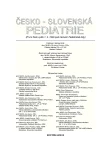Body Temperature and Thermoregulation in the Newborn
Authors:
M. Procházková 1; J. Janota 1,2
Authors‘ workplace:
Novorozenecké oddělení s JIPN, Fakultní Thomayerova nemocnice s poliklinikou, Praha
primář doc. MUDr. J. Janota, PhD.
1; Ústav patologické fyziologie UK 1. LF, Praha
přednosta prof. MUDr. E. Nečas, DrSc.
2
Published in:
Čes-slov Pediat 2010; 65 (6): 401-405.
Category:
Review
Overview
Humans have an ability to keep their body temperature stable in relatively wide range of outer temperatures. Temperature loss caused by convection, radiation, evaporation and conduction can be compensated by increased heat production from metabolic muscle activity. This shivering thermogenesis in the newborn is limited, and the heat is created in the brown fat tissue. This method requires an extra energy and oxygen, which may have the negative influence on stability of the neonate.
The goal of thermo management of the newborn is to avoid a temperature stress and to keep the neutral temperature environment. The body temperature measurement and the knowledge of its physiological range in relation to a place of measurement is a tool to keep newborn stable. We provide a range of environmental temperatures for different groups of newborns according to postnatal age and birth weight.
Key words:
body temperature, thermo neutral environment, hypothermia, hyperthermia
Sources
1. Rennie JM. Roberton´s Textbook of Neonatology. 4th ed. Elsevier, 2005 : 148–159.
2. Fanaroff AA, Martin RJ. Neonatal – Perinatal Medicine. Vol. I. 6th ed. Mosby-Year Book, Inc., 1997 : 418–419, 481–501.
3. Bell EF. Infant incubators and radiant warmers. Early Hum. Dev. 1983; 8 : 351–375.
4. Avery GB. Neonatology. 4th ed. J. B. Lippincott Comp., 1994 : 274–275, 301–302, 314–315, 357–365.
5. Levitt G, Harvey D, Cooke R. Practical Perinatal Care: The baby under 1000 grams. 1st ed. Reed Educational and Professional Publishing Ltd., 1999 : 78.
6. Fanaroff AA, et al. Insensible water loss in low birth weight infants. Pediatrics 1972; 50 : 236.
7. Mayfield SR, Bhatia J, Nakamura KT, Rios GR, Bell EF. Temperature measurement in term and preterm neonates. J. Pediatr. 1984; 104 : 271–275..
8. Scopes JW, et al. Range of initial temperatures in sick and premature newborn babies. Arch. Dis. Child. 1966; 41 : 417.
9. Craig JV, Lancaster GA, Williamson PR, Smyth RL. Temperature measured at the axilla compared with rectum in children and young people: systematic review. BMJ 2000; 320 : 1174–1178.
10. Jones HL, Kleber CB, Eckert GJ, Mahon BE. Comparison of rectal temperature measured by digital vs. mercury glass thermometer in infants under two months old. Clin. Pediatr. 2003; 42 : 357–359.
11. Flenady VJ, Woodgate PG. Radiant warmers versus incubators for regulating body temperature in newborn infants. Cochrane Database Syst. Rev. 2003; 4.
12. Sinclair JC. Servo-control for maintaining abdominal skin temperature at 36 °C in low birth weight infants. Cochrane Database Syst. Rev. 2002; 1.
13. Gomella TL, Cunningham MD, et al. Neonatology. 5th ed. The McGraw-Hill Comp., Inc., 2004 : 39–43.
14. Scopes JW, et al. Minimal rates of oxygen consumption in sick and premature infants. Arch. Dis. Child. 1966; 41 : 407.
15. Meyer MP, Payton MJ, Salmon A, et al. A clinical comparison of radiant warmer and incubator care for preterm infants from birth to 1800 grams. Pediatrics 2002; 110 : 424–425.
Labels
Neonatology Paediatrics General practitioner for children and adolescentsArticle was published in
Czech-Slovak Pediatrics

2010 Issue 6
- What Effect Can Be Expected from Limosilactobacillus reuteri in Mucositis and Peri-Implantitis?
- The Importance of Limosilactobacillus reuteri in Administration to Diabetics with Gingivitis
Most read in this issue
- Body Temperature and Thermoregulation in the Newborn
- Rapidly Progressive Complications of the Influenza A Type in Children
- Methotrexate in Children with Juvenile Idiopathic Arthritis
- Thromboembolic Events in Girls and Young Women Taking Hormonal Contraception
